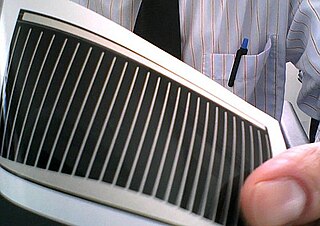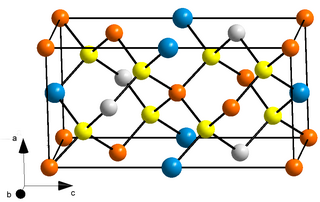
Photovoltaics (PV) is the conversion of light into electricity using semiconducting materials that exhibit the photovoltaic effect, a phenomenon studied in physics, photochemistry, and electrochemistry. The photovoltaic effect is commercially used for electricity generation and as photosensors.

Copper indium gallium (di)selenide (CIGS) is a I-III-VI2 semiconductor material composed of copper, indium, gallium, and selenium. The material is a solid solution of copper indium selenide (often abbreviated "CIS") and copper gallium selenide. It has a chemical formula of CuIn1−xGaxSe2, where the value of x can vary from 0 (pure copper indium selenide) to 1 (pure copper gallium selenide). CIGS is a tetrahedrally bonded semiconductor, with the chalcopyrite crystal structure, and a bandgap varying continuously with x from about 1.0 eV (for copper indium selenide) to about 1.7 eV (for copper gallium selenide).
Nanosolar was a developer of solar power technology. Based in San Jose, CA, Nanosolar developed and briefly commercialized a low-cost printable solar cell manufacturing process. The company started selling thin-film CIGS panels mid-December 2007, and planned to sell them at 99 cents per watt, much below the market at the time. However, prices for solar panels made of crystalline silicon declined significantly during the following years, reducing most of Nanosolar's cost advantage. By February 2013 Nanosolar had laid off 75% of its work force. Nanosolar began auctioning off its equipment in August 2013. Co-Founder of Nanosolar Martin Roscheisen stated on his personal blog that nanosolar "ultimately failed commercially." and that he would not enter this industry again because of slow-development cycle, complex production problems and the impact of cheap Chinese solar power production. Nanosolar ultimately produced less than 50 MW of solar power capacity despite having raised more than $400 million in investment.

Building-integrated photovoltaics (BIPV) are photovoltaic materials that are used to replace conventional building materials in parts of the building envelope such as the roof, skylights, or facades. They are increasingly being incorporated into the construction of new buildings as a principal or ancillary source of electrical power, although existing buildings may be retrofitted with similar technology. The advantage of integrated photovoltaics over more common non-integrated systems is that the initial cost can be offset by reducing the amount spent on building materials and labor that would normally be used to construct the part of the building that the BIPV modules replace. In addition, BIPV allows for more widespread solar adoption when the building's aesthetics matter and traditional rack-mounted solar panels would disrupt the intended look of the building.
HelioVolt Corporation was a privately held solar energy company based in Austin, Texas. that suspended operations in 2014. The company manufactured photovoltaic (PV) solar modules using a thin film semiconductor process based on copper indium gallium selenide (CIGS) to produce CIGS solar cells. HelioVolt manufactured these thin film modules for commercial rooftop, utility-scale ground mount, residential, building-integrated photovoltaics (BIPV) and custom installations. The company raised over $230 million in investments, including over $80 million by SK Group.
MiaSolé is an American solar energy company selling copper indium gallium selenide (CIGS) thin-film photovoltaic products. MiaSolé's manufacturing process lays CIGS on a flexible stainless steel substrate. MiaSolé produces all layers of photovoltaic material in a continuous sputtering process.
International Solar Electric Technology, or ISET, was a company invested in copper indium gallium selenide (CIGS) photovoltaics. ISET's research over two decades had been largely funded by grants from the National Renewable Energy Laboratory. Members helped found or worked in many of the more well known CIGS companies, such as Nanosolar, Solopower, Showa, and Honda Soltec Despite a lack of venture capital, ISET planned to launch a thin film, produced in a new Chatsworth plant with hundreds of megawatts per year capacity after the pilot plant is proven. The company believed they will be able to at first achieve 10% efficient modules sold for $0.65 per watt, then 15% efficient for $0.50 per watt, and potentially ultimately as low as $0.40 per watt.
Global Solar Energy is a US-based manufacturer of CIGS solar cells, a thin-film based photovoltaic technology, with manufacturing operations in Tucson, Arizona, United States, and Berlin, Germany. In 2013, it was bought by Chinese renewable energy company Hanergy.

Ascent Solar Technologies, Inc. is a publicly traded photovoltaic (PV) company located in Thornton, Colorado. Its primary product is a flexible CIGS solar cell on a plastic substrate.

Cadmium telluride (CdTe) photovoltaics is a photovoltaic (PV) technology based on the use of cadmium telluride in a thin semiconductor layer designed to absorb and convert sunlight into electricity. Cadmium telluride PV is the only thin film technology with lower costs than conventional solar cells made of crystalline silicon in multi-kilowatt systems.
Odersun was a German photovoltaic (PV) company that developed and manufactured CIGS cells on a flexible copper backing, specifically designed for building-integrated photovoltaics. The insolvent company went into administration on 1 June 2012 and filed for bankruptcy.

A thin-film solar cell is a second generation solar cell that is made by depositing one or more thin layers, or thin film (TF) of photovoltaic material on a substrate, such as glass, plastic or metal. Thin-film solar cells are commercially used in several technologies, including cadmium telluride (CdTe), copper indium gallium diselenide (CIGS), and amorphous thin-film silicon.

A copper indium gallium selenide solar cell is a thin-film solar cell used to convert sunlight into electric power. It is manufactured by depositing a thin layer of copper indium gallium selenide solution on glass or plastic backing, along with electrodes on the front and back to collect current. Because the material has a high absorption coefficient and strongly absorbs sunlight, a much thinner film is required than of other semiconductor materials.

Crystalline silicon or (c-Si) Is the crystalline forms of silicon, either polycrystalline silicon, or monocrystalline silicon. Crystalline silicon is the dominant semiconducting material used in photovoltaic technology for the production of solar cells. These cells are assembled into solar panels as part of a photovoltaic system to generate solar power from sunlight.

Copper zinc tin sulfide (CZTS) is a quaternary semiconducting compound which has received increasing interest since the late 2000s for applications in thin film solar cells. The class of related materials includes other I2-II-IV-VI4 such as copper zinc tin selenide (CZTSe) and the sulfur-selenium alloy CZTSSe. CZTS offers favorable optical and electronic properties similar to CIGS (copper indium gallium selenide), making it well suited for use as a thin-film solar cell absorber layer, but unlike CIGS (or other thin films such as CdTe), CZTS is composed of only abundant and non-toxic elements. Concerns with the price and availability of indium in CIGS and tellurium in CdTe, as well as toxicity of cadmium have been a large motivator to search for alternative thin film solar cell materials. The power conversion efficiency of CZTS is still considerably lower than CIGS and CdTe, with laboratory cell records of 11.0 % for CZTS and 12.6 % for CZTSSe as of 2019.
Hanergy Holding Group Ltd. (Hanergy) is a Chinese multinational company headquartered in Beijing. The company is focusing on thin-film solar value chain, including manufacturing and solar parks development. It also owns the Jinanqiao Hydroelectric Power Station and two wind farms.
Light soaking refers to the change in power output of solar cells which can be measured after illumination. This can either be an increase or decrease, depending on the type of solar cell. The cause of this effect and the consequences on efficiency varies per type of solar cell. Light soaking can generally cause either metastable electrical or structural effects. Electrical effects can vary the efficiency depending on illumination, electrical bias and temperature, where structural effects actually changes the structure of the material and performance is often permanently altered.








